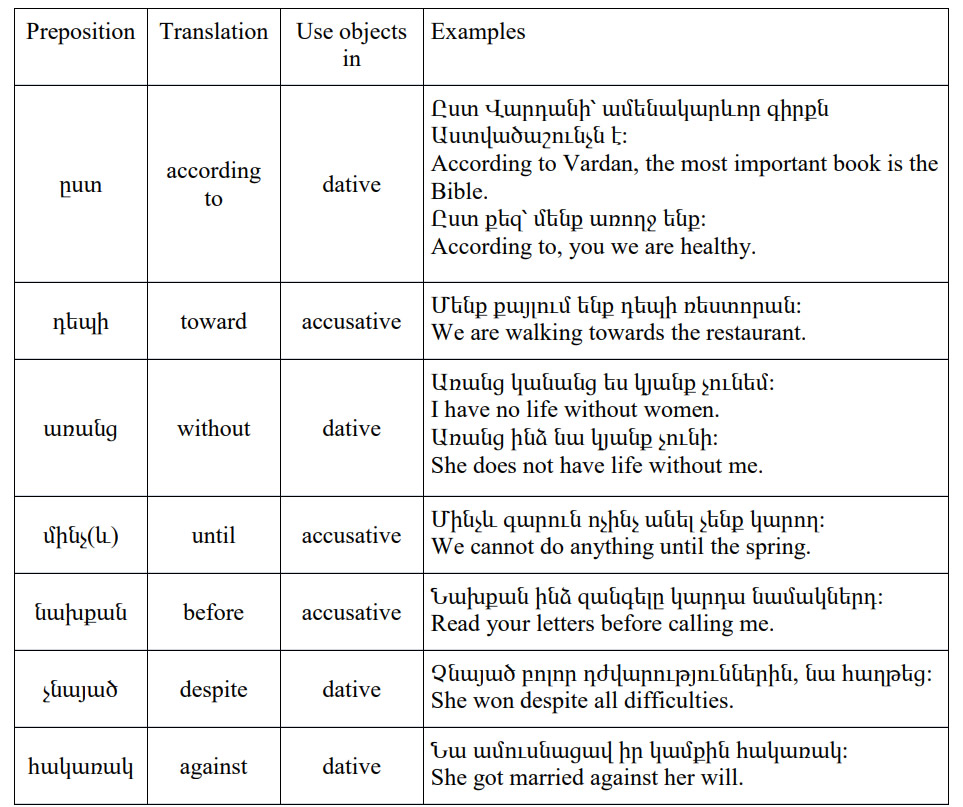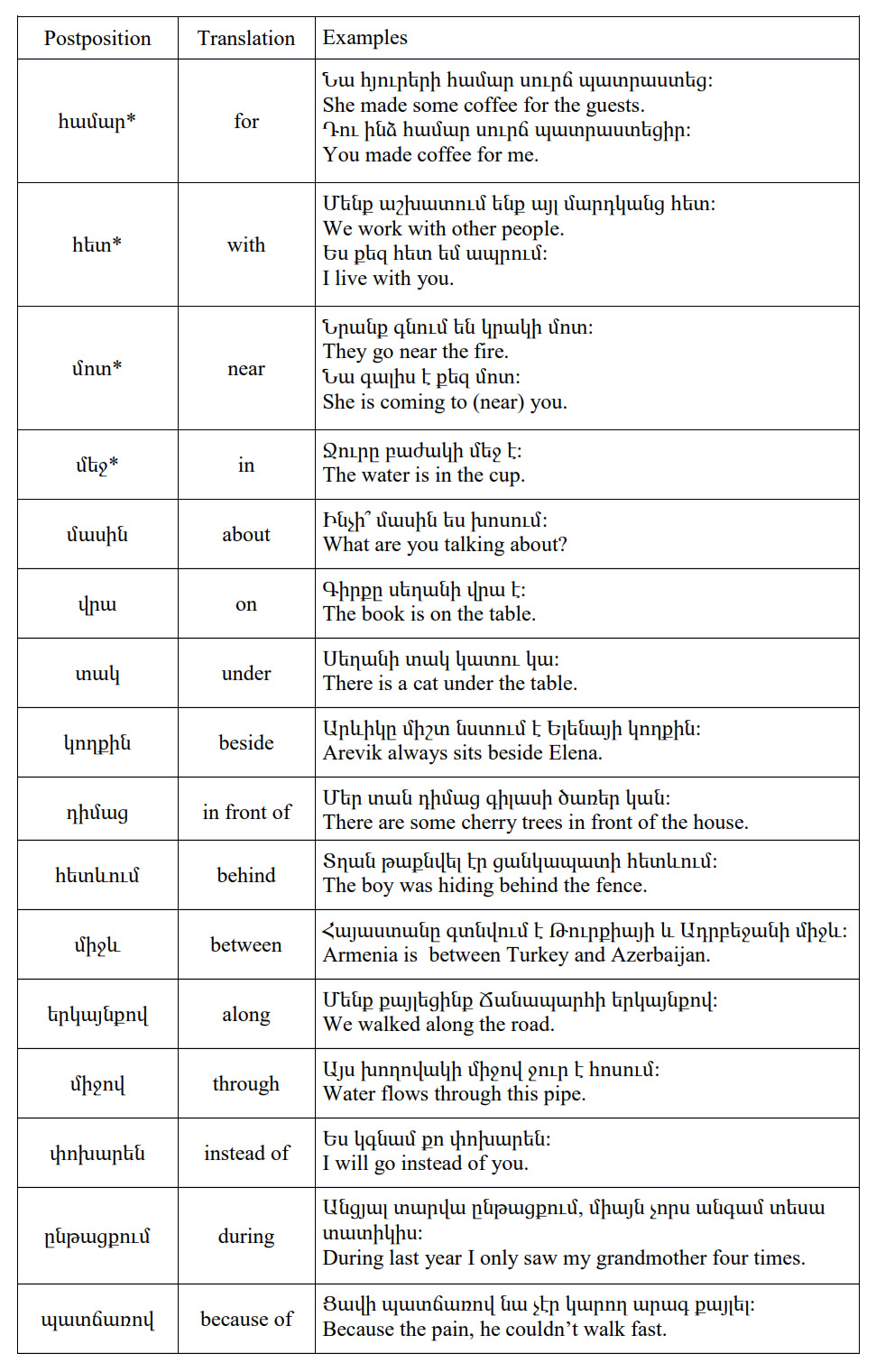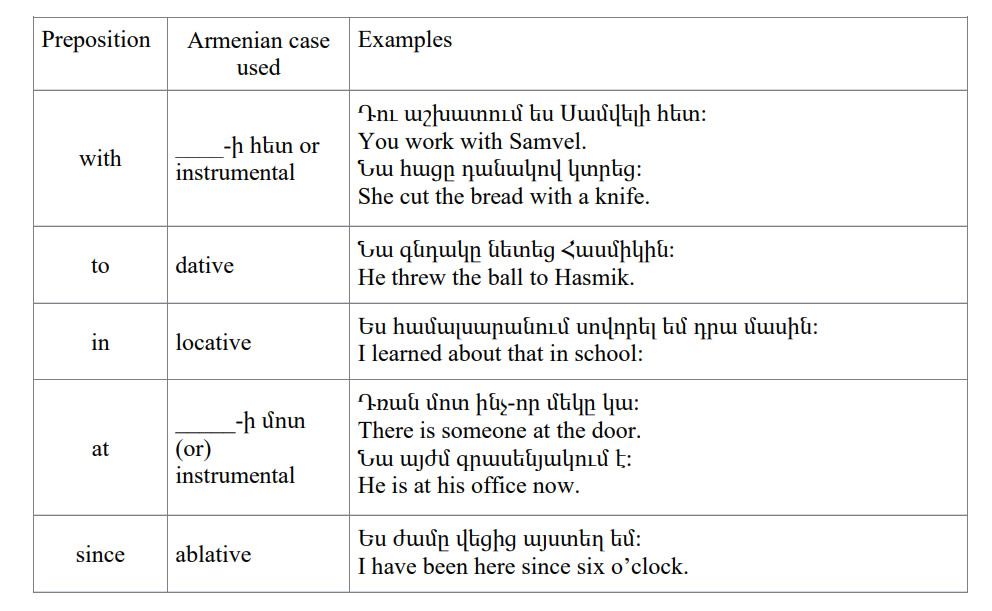Difference between revisions of "Language/Armenian/Grammar/Prepositions-and-Postpositions"
(Created page with "thumb <div style="font-size:300%"> Prepositions and Postpositions in Armenian</div> __TOC__ In the Armenian language there are...") |
|||
| Line 6: | Line 6: | ||
In the Armenian language there are both prepositions and postpositions. The chart below lists most commonly used prepositions, their translations and sentences using the prepositions are presented. The list also suggests a strategy to build grammatically correct sentences with these prepositions. | In the Armenian language there are both prepositions and postpositions. | ||
==Most common used Prepositions== | |||
The chart below lists most commonly used prepositions, their translations and sentences using the prepositions are presented. The list also suggests a strategy to build grammatically correct sentences with these prepositions. | |||
[[File:Armenian-Language-Prepositions and Postpositions PolyglotClub.jpg]] | [[File:Armenian-Language-Prepositions and Postpositions PolyglotClub.jpg]] | ||
==Postpositions taking objects which have the form of the genitive case== | |||
The objects of above prepositions that require objects in dative case, do not get the definite article ը or ն: As examples above suggest չնայած and հակառակ are exceptions. All of the below postpositions take objects which have the form of the genitive case. Some of these postpositions actually take objects in dative but these objects never take the definite article. See the remark below the chart. | The objects of above prepositions that require objects in dative case, do not get the definite article ը or ն: As examples above suggest չնայած and հակառակ are exceptions. All of the below postpositions take objects which have the form of the genitive case. Some of these postpositions actually take objects in dative but these objects never take the definite article. See the remark below the chart. | ||
| Line 16: | Line 20: | ||
[[File:Armenian-Language-Prepositions and Postpositions 2 PolyglotClub.jpg]] | [[File:Armenian-Language-Prepositions and Postpositions 2 PolyglotClub.jpg]] | ||
==Postpositions requiring Ablatives== | |||
Not all postpositions require objects in genitive case. | |||
Some postpositions require ablatives. For instance: | |||
[[File:Armenian-Language-Prepositions and Postpositions 3 PolyglotClub.jpg]] | [[File:Armenian-Language-Prepositions and Postpositions 3 PolyglotClub.jpg]] | ||
<nowiki>*</nowiki> If the prepositions ըստ, առանց and postpositions հետ, մոտ and համար refer to pronouns ես, դու, մենք, and դուք, these pronouns stand in dative. Thus, “about me” translates as ինձ համար, (and not իմ համար), “near you” translates as քեզ մոտ, “without us” translates as առանց մեզ, “in you” translates as “քեզ մեջ”, “ձեզ մեջ” etc. Some commonly used prepositions in English are rendered by case endings or a combination of case endings and postpositions in Armenian. We have already learned about many of these instances when we learned the cases of the Armenian language. | <nowiki>*</nowiki> If the prepositions ըստ, առանց and postpositions հետ, մոտ and համար refer to pronouns ես, դու, մենք, and դուք, these pronouns stand in dative. Thus, “about me” translates as ինձ համար, (and not իմ համար), “near you” translates as քեզ մոտ, “without us” translates as առանց մեզ, “in you” translates as “քեզ մեջ”, “ձեզ մեջ” etc. | ||
Some commonly used prepositions in English are rendered by case endings or a combination of case endings and postpositions in Armenian. We have already learned about many of these instances when we learned the cases of the Armenian language. | |||
Revision as of 17:58, 27 September 2021
In the Armenian language there are both prepositions and postpositions.
Most common used Prepositions
The chart below lists most commonly used prepositions, their translations and sentences using the prepositions are presented. The list also suggests a strategy to build grammatically correct sentences with these prepositions.
Postpositions taking objects which have the form of the genitive case
The objects of above prepositions that require objects in dative case, do not get the definite article ը or ն: As examples above suggest չնայած and հակառակ are exceptions. All of the below postpositions take objects which have the form of the genitive case. Some of these postpositions actually take objects in dative but these objects never take the definite article. See the remark below the chart.
Postpositions requiring Ablatives
Not all postpositions require objects in genitive case.
Some postpositions require ablatives. For instance:
 * If the prepositions ըստ, առանց and postpositions հետ, մոտ and համար refer to pronouns ես, դու, մենք, and դուք, these pronouns stand in dative. Thus, “about me” translates as ինձ համար, (and not իմ համար), “near you” translates as քեզ մոտ, “without us” translates as առանց մեզ, “in you” translates as “քեզ մեջ”, “ձեզ մեջ” etc.
* If the prepositions ըստ, առանց and postpositions հետ, մոտ and համար refer to pronouns ես, դու, մենք, and դուք, these pronouns stand in dative. Thus, “about me” translates as ինձ համար, (and not իմ համար), “near you” translates as քեզ մոտ, “without us” translates as առանց մեզ, “in you” translates as “քեզ մեջ”, “ձեզ մեջ” etc.
Some commonly used prepositions in English are rendered by case endings or a combination of case endings and postpositions in Armenian. We have already learned about many of these instances when we learned the cases of the Armenian language.
Sources
https://slaviccenters.duke.edu/sites/slaviccenters.duke.edu/files/handbook_of_armenian.pdf



